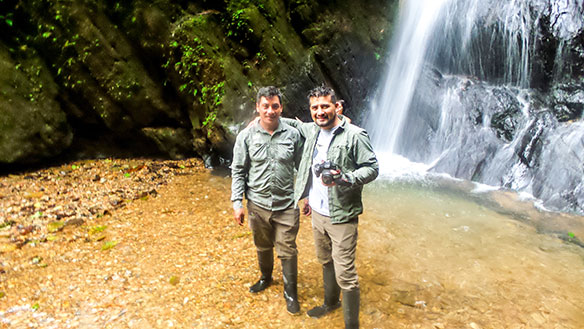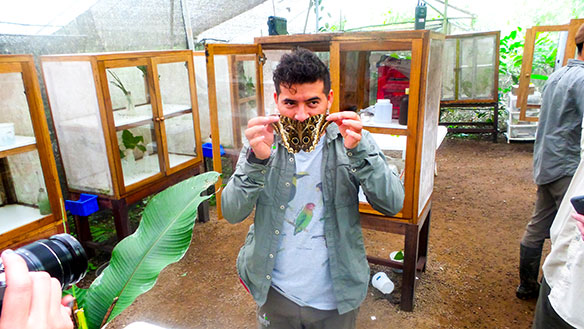
Cloud forest lodge’s staff knows its feathered friends
IAN STALKER
(Photo above: Mashpi Lodge’s Klever Merino (l) and Nestor Paladines stand before an area waterfall.)
Anyone skeptical that the staff at Ecuador’s Mashpi Lodge don’t know their stuff need only look at tour guide Nestor Paladines.
Paladines, a guide at the National Geographic-affiliated property, can identify some 1,068 bird species in his country by their English and Spanish names and about 400 by their scientific monikers.
And to top that off, he can recognize hundreds of species by their calls, with those feats taking three years.
And says lodge manager Marc Bery, that sort of dedication enables Mashpi guests to head home with a better understanding of the cloud forest region that they visited.
“The big idea for people coming here is to help them know what nature is, what cloud forest is,” he says.
Mashpi is found in a thickly forested part of the world that once saw logging, prompting a group to buy a large swathe of land to safeguard it from development, with Bery noting that, today’s guests will find a “very healthy forest. Our next door neighbour is 10 miles away.”
The lodge is on a plateau 950 metres above sea level that’s in a reserve that covers terrain from 500 to 1,200 metres above sea level and shelters a host of creatures, among them pumas, toucans and parakeets.
But Bery says 24-guest unit Mashpi’s remote location doesn’t mean guests will have to sacrifice creature comforts, with the Mexico City native pronouncing his retreat “very comfortable,” with guests offered the likes of a spa, restaurant, bar, shop, and a spa.
Other features include a viewing platform.
The lodge has a contemporary look that includes floor-to-ceiling windows.
A laboratory helps staff gain insights into local flora and fauna.
“We spend a great deal of time, money and effort to have things running smoothly,” Bery continues.
Guests are also offered guided hikes, including pre-breakfast sojourns for birdwatchers eager to see some of the area’s feathered friends right after sunrise. “You have to be an early bird to [best] see the birds,” advises Bery.
More than 20 activities are available for Mashpi guests, some of which – such as The Sky Bike – provide visitors with aerial looks at the area.
“That’s our purpose,” Bery says. “If you come here, you understand how nature works. If we manage for you to understand a tropical forest, our job is done.”
More information can be found at mashpi.com .
Among airlines serving Quito is Panamanian carrier Copa, which also includes Montreal and Toronto in its network.
Life Centre provides
ongoing air show
IAN STALKER
Some permanent Mashpi lodge residents clearly know a thing or two about winging it.
The Lodge’s Life Center is home to the Fly Area, an enclosed area in which at least 18 species of colourful butterflies can be found fluttering about.
Mashpi Lodge guide Nestor Paladines says Fly Area vegetation includes plants needed by each different butterfly species.
Visitors and staff enter and leave through two doors to ensure none of the butterflies work their way outside.
Butterflies generally have short life cycles, and the Life Center also displays different dead butterflies, including a large one that has a camouflage pattern that looks remarkably close to an owl’s face, a defence mechanism aimed at scaring away predators.
Paladines says butterflies born in the Fly Area are fortunate, receiving constant nutritious food and being protected from predators, with Fly Area butterflies much more likely to survive infancy than wild butterflies.


